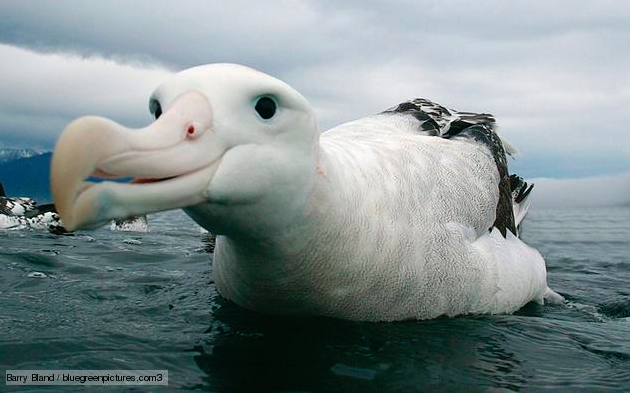"No bird soars too high, if he soars with his own
wings." William Blake
This week let’s soar
to the sky with the Wandering Albatross.
There are twenty-two species of Albatross, but I choose to
write about the Wandering Albatross because it is the largest flying bird in
the world. Its wingspan can reach up to eleven and one-half feet. That’s
impressive! As a matter of fact there is a room in my house that this Albatross
could not stretch out in. Now that I think of it, there are a couple of rooms
in my house in which he would be very uncomfortable.
Before we go any further, I would like to give the children
reading this post, a bit of a geography lesson. I know I have a few third grade
classes that visit and I thought this would be a good time to explain the
Arctic and the Antarctic. I remember how confused I was about these two
landmasses, or circles as they are often referred to. I never could remember
which was the top and which was the bottom. It is important to know this. The
Arctic Circle is north of us. Think about it as over our heads. The Antarctic
Circle is below us, at our feet. Or if you like, and it helps you to remember,
The Arctic Circle is also called the North Pole (Santa’s hangout). The
Antarctic Circle is also called the South Pole (Wandering Albatross hangout).
Please keep in mind that the names North Pole and the South Pole are only theoretical
points and not real places. The real place names are Arctic and Antarctic.
This picture should help. Be sure to locate your country on
the map. It will give you a reference point.
The Wandering Albatross lives near Antarctica. They can be
found on several islands southeast of the Horn of Africa.
Map Courtesy of
Wikipedia
All species of Albatross are seabirds. They are not like the
birds outside your window, perched and twittering on a nearby tree. Seabirds
live most of their lives in flight, landing only to nest and raise their young.
The Wandering Albatross has been tracked and scientists know that they can fly
up to 10,000 miles in a single journey.
Wandering Albatross mate for life and the female will lay
one egg, but the male and female take turns incubating (sitting on them to keep them warm) their chick.
They will also feed their baby bird for about nine months, until the chick is
ready to fly. A parent will fly as far as 5000 miles in order to collect food
for its chick. A baby Albatross will sit alone on its nest for months until it
is capable of heading out on its own. The chicks have chocolate brown feathers
and it will take up to nine years for their adult plumage to grow in. A nine-month-old
chick can weigh as much as or more than its mother.
Juvenile Wandering
Albatross - Photo courtesy of: http://thebirdguide.com
An Albatross has a varied seafood diet. They will eat squid,
octopus, crab, shrimp, lobsters and other crustaceans
(hard shelled animal) they find floating on the surface. They spy their food
while flying over the ocean, and then swoop down to scoop it up. They can dive
up to 15 feet deep to grab their dinner.
Photo
courtesy of: http://www.bbc.co.uk
The biggest threat to this magnificent bird is a fishing net.
The Albatross will follow fishing boats to steal the bait from the fishing
hooks. They then get caught in the fishing nets and drown. In order to counter
this problem many of their nesting sites have been protected. “The majority of wandering
albatross breeding sites are protected within reserves, and the island of
Macquarie is a World Heritage Site. This species also receives protection under
Appendix II of the Convention on Migratory Species and studies of a number of
breeding populations have recently been undertaken.” (http://www.arkive.org/wandering-albatross/diomedea-exulans/image-G6732.html)
According to our friends at the IUCN*, the Wandering
Albatross is vulnerable.
I have found a wonderful video narrated by David
Attenborourgh.
Here are some
web sites to explore if you wish to learn more.
Before I leave you, I would like you to go back to the top
of the post and read the quote by author William Blake. It doesn’t really have
anything to do with the Albatross, but it has much meaning. After you have
considered it, I would love to hear what the quote means to you.
It was fun to write this blog for you. I hope you enjoyed
it, and will consider leaving me a comment, or sharing the blog with your
friends and family. As you can see from the below picture, the Albatross had a lot of fun too!
As always, my sincere thanks to Arkive.org, and bbc.co.uk,
for pictures and information.
Enjoy,
Jeanne E. Rogers, Author
The Sword of Demelza
An Award Winning Middle Grade Fantasy Where Endangered
Animals Heroes Roam the Pages








